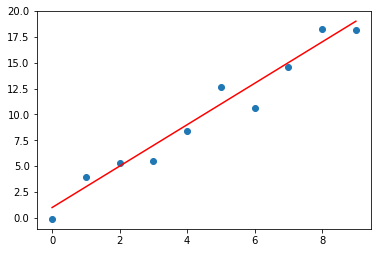Regression in TensorFlow¶
In [1]:
%matplotlib inline
import matplotlib.pyplot as plt
import numpy as np
In [2]:
import warnings
warnings.simplefilter(action='ignore', category=FutureWarning)
import h5py
warnings.resetwarnings()
warnings.simplefilter(action='ignore', category=ImportWarning)
warnings.simplefilter(action='ignore', category=RuntimeWarning)
warnings.simplefilter(action='ignore', category=DeprecationWarning)
warnings.simplefilter(action='ignore', category=ResourceWarning)
In [3]:
import tensorflow as tf
Steps in fittting a model¶
- Define model variables (parameters) and placeholders (data)
- Define the loss function
- Choose an optimizer to minimize the loss
- Start a session
- Initialize global variables
- Run the optimizer for \(n\) steps or epochs, feeding in appropriate data
Linear Regression¶
In [4]:
np.random.seed(123)
In [5]:
N = 10
W_true = 2
b_true = 1
X_obs = np.arange(N).reshape((-1,1))
eps = np.random.normal(0, 1, (N, 1))
y_obs = np.reshape(W_true * X_obs + b_true + eps, (-1, 1))
In [6]:
plt.scatter(X_obs, y_obs)
plt.plot(X_obs, W_true * X_obs + b_true, c='red')
pass

In [7]:
X = tf.placeholder(tf.float32, (N, 1))
y = tf.placeholder(tf.float32, (N, 1))
W = tf.Variable(tf.random_normal((1,1)))
b = tf.Variable(tf.random_normal((1,)))
yhat = tf.matmul(X, W) + b
loss = tf.reduce_sum(tf.square(y - yhat))
train_op = tf.train.GradientDescentOptimizer(learning_rate=0.001).minimize(loss)
init_op = tf.global_variables_initializer()
In [8]:
niter = 1001
with tf.Session() as sess:
sess.run(init_op)
for i in range(niter):
_, weights, bias, l = sess.run([train_op, W, b, loss], feed_dict={X: X_obs, y: y_obs})
if i % 100 == 0:
print('%03d\t%6.2f\t%6.2f\t%6.2f' % (i, weights[0][0], bias[0], l))
000 0.06 1.35 984.14
100 1.92 1.25 16.04
200 1.95 1.03 15.53
300 1.97 0.90 15.36
400 1.98 0.83 15.31
500 1.99 0.79 15.29
600 1.99 0.77 15.29
700 2.00 0.75 15.29
800 2.00 0.75 15.28
900 2.00 0.74 15.28
1000 2.00 0.74 15.28
Logistic Regression¶
We will use logistic regreesion to predict entry to graduate school based on GRE, GPA and rank of undegraduate college by prestige (1 = highest, 4= lowest).
In [9]:
import pandas as pd
In [10]:
df = pd.read_csv('https://stats.idre.ucla.edu/stat/data/binary.csv')
In [11]:
df.head()
Out[11]:
| admit | gre | gpa | rank | |
|---|---|---|---|---|
| 0 | 0 | 380 | 3.61 | 3 |
| 1 | 1 | 660 | 3.67 | 3 |
| 2 | 1 | 800 | 4.00 | 1 |
| 3 | 1 | 640 | 3.19 | 4 |
| 4 | 0 | 520 | 2.93 | 4 |
In [12]:
df = pd.get_dummies(df, columns=['rank'], drop_first=True)
df.head()
Out[12]:
| admit | gre | gpa | rank_2 | rank_3 | rank_4 | |
|---|---|---|---|---|---|---|
| 0 | 0 | 380 | 3.61 | 0 | 1 | 0 |
| 1 | 1 | 660 | 3.67 | 0 | 1 | 0 |
| 2 | 1 | 800 | 4.00 | 0 | 0 | 0 |
| 3 | 1 | 640 | 3.19 | 0 | 0 | 1 |
| 4 | 0 | 520 | 2.93 | 0 | 0 | 1 |
Reset the data flow graph.
In [13]:
N = df.shape[0]
X = tf.placeholder(tf.float32, (N, 5))
y = tf.placeholder(tf.float32, (N, 1))
W = tf.Variable(tf.random_normal((5,1)))
b = tf.Variable(tf.random_normal((1,)))
yhat = tf.matmul(X, W) + b
In [14]:
loss = tf.reduce_sum(tf.nn.sigmoid_cross_entropy_with_logits(logits=yhat, labels=y))
In [15]:
train_op = tf.train.AdamOptimizer().minimize(loss)
init_op = tf.global_variables_initializer()
In [16]:
niter = 25001
with tf.Session() as sess:
sess.run(init_op)
for i in range(niter):
_, weights, bias, l = sess.run([train_op, W, b, loss], feed_dict={X: df.iloc[:, 1:], y: df.iloc[:, 0:1]})
if i % 5000 == 0:
print((i, weights.T[0], bias[0], l))
(0, array([-1.3257291 , -0.302939 , 1.9480195 , -0.17506851, 0.37787107],
dtype=float32), -0.5002541, 104295.26)
(5000, array([-0.00137983, 0.17184952, 0.4647249 , -0.5058274 , -0.73989314],
dtype=float32), -0.38277972, 249.21332)
(10000, array([ 0.00200241, 0.35402513, -0.79581696, -1.4096469 , -1.6802471 ],
dtype=float32), -2.1872034, 230.55487)
(15000, array([ 0.00223551, 0.74499196, -0.6892415 , -1.3469222 , -1.5659412 ],
dtype=float32), -3.7580762, 229.27982)
(20000, array([ 0.00226194, 0.79895586, -0.67662704, -1.340773 , -1.5527016 ],
dtype=float32), -3.9700239, 229.25891)
(25000, array([ 0.00225878, 0.80363715, -0.6757183 , -1.3404499 , -1.551768 ],
dtype=float32), -3.9884007, 229.25922)
R fit for comparison¶
## Call:
## glm(formula = admit ~ gre + gpa + rank, family = "binomial",
## data = mydata)
##
## Deviance Residuals:
## Min 1Q Median 3Q Max
## -1.627 -0.866 -0.639 1.149 2.079
##
## Coefficients:
## Estimate Std. Error z value Pr(>|z|)
## (Intercept) -3.98998 1.13995 -3.50 0.00047 ***
## gre 0.00226 0.00109 2.07 0.03847 *
## gpa 0.80404 0.33182 2.42 0.01539 *
## rank2 -0.67544 0.31649 -2.13 0.03283 *
## rank3 -1.34020 0.34531 -3.88 0.00010 ***
## rank4 -1.55146 0.41783 -3.71 0.00020 ***
## ---
## Signif. codes: 0 '***' 0.001 '**' 0.01 '*' 0.05 '.' 0.1 ' ' 1
##
## (Dispersion parameter for binomial family taken to be 1)
##
## Null deviance: 499.98 on 399 degrees of freedom
## Residual deviance: 458.52 on 394 degrees of freedom
## AIC: 470.5
##
## Number of Fisher Scoring iterations: 4